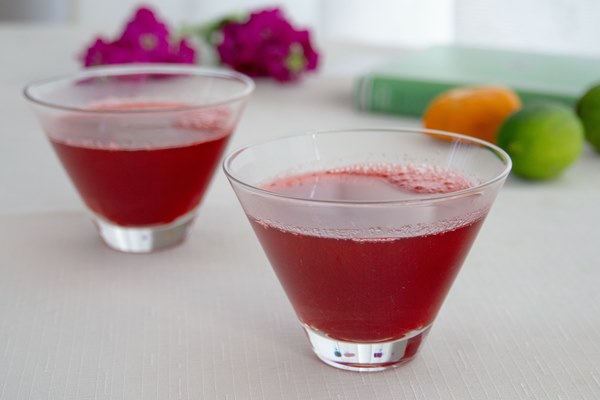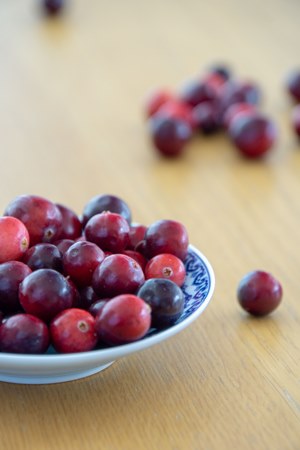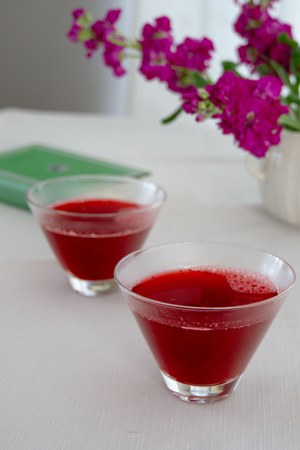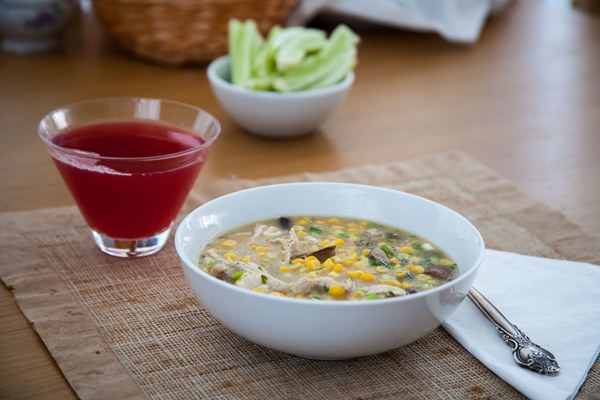I love the bold acidity of cranberries. Sometimes when I cook with them, I keep a few berries aside to eat raw and their combination of bitterness and tartness always takes me by surprise. Yet, if I wait a moment, I taste a floral sweetness, with a hint of red currant. When I make something with cranberries, I select simple recipes that allow these facets to shine, and more of often than not, I return to my grandmother’s recipe for cranberry mors, a fruit drink.

Mors is the whole world of Russian fruit beverages made with strawberries, currants, gooseberries, blueberries or cloudberries, those unique berries with a taste of cardamom that grow in the northern lands. My paternal grandmother Daria was born in the region of Russia edged in between Ukraine and Belarus, and she remembered going to the forest to pick berries and prepare enough mors to last the family of 12 through the winter.
The traditional method to make cranberry mors was to cover berries with water and leave them to ferment naturally. However, when Daria moved to Ukraine and settled in Kyiv, the capital city, she began to make mors differently, by cooking the berries. Daria’s recipe was simple, but it was ingenious in the way it preserved vitamins and freshness.
Instead of boiling berries with sugar, which was what most other cooks would do, my grandmother first squeezed the juice out of cranberries and then simmered the skins with water. She strained the skins, added sugar, gave the preparation one more minute of simmering and then added the fresh juice. Her mors retained the essence of the berries, and it was mildly sweetened and fragrant.


American cranberries are tougher than the delicate berries Daria’s brother used to send from the north of Russia, so I’ve adapted her method slightly. My mors also tastes fresh and bright, with just enough sweetness to take off the tannic edge of cranberries without masking their natural aromas.
Daria always added a pinch of salt to mors, explaining that “it made the berries sing.” Salt indeed volatilizes the aromas, so this minute addition makes a difference.

Cranberry Mors (Drink) Recipe
19th century Russian cookbooks often recommend adding rosewater to cranberry drinks or jams. It makes for an elegant twist on the tart berry flavor. If you’d like to try it, add 1/2-1 teaspoon of rosewater in the last step of this recipe. I prefer the simplicity of my grandmother’s version, which allows all of the berry nuances to shine.
If you want to adapt this mors recipe to softer berries like raspberries, strawberries or lingonberries, skip cooking them in the first step. Simply squeeze the juice out, set it aside and proceed with the rest of the recipe. I find, however, that blackberries and blueberries require brief cooking to intensify their flavor.
1/3 cup of sugar makes for a pleasantly tart drink, but feel free to adjust the quantity to your taste.
2 cups (200g) fresh or frozen cranberries
4 cups (1L) water
1/3 c (65g) sugar or to taste
a pinch of salt
In a pot, combine cranberries with 1 cup of water and bring to boil. Simmer until the berries burst, a couple of minutes. You only want to soften them. Remove from the heat and sieve the berries (and any liquid remaining in the pot) and set the juice aside. Transport the skins remaining in the sieve into the pot, add 3 cups of water and bring to a gentle boil. Simmer for 5-7 minutes to allow the color and flavor to intensify. Add sugar and salt. Remove from the heat, add the sieved juice, and correct the quantity of sugar to your taste.
Mors is delicious both cold and hot.
Photography by Bois de Jasmin
















26 Comments
Marsha Smith: I love reading about your family recipes! October 26, 2018 at 10:06am
Victoria: Thank you! October 26, 2018 at 10:51am
Celeste Church: Your family made exotic cranberry drinks….my family heated Dr. Pepper at Christmas and put a lemon wedge in it! 🙂 our version of exotic, I guess. I like yours better! October 26, 2018 at 10:31am
Victoria: My childhood fell onto the worst years of the Soviet shortages, when stores had pretty much nothing. But for some reason, frozen cranberries were always available. It’s a testament to my grandmothers’ culinary skills that they could take the simplest, most un-exotic ingredients and turn them into something delicious. October 26, 2018 at 10:50am
Celeste Church: And that’s the mark of a great cook….taking what you have and creating something wonderful out of it. October 26, 2018 at 10:59am
Victoria: My paternal grandmother cooked a few dishes, but she made them really well. October 26, 2018 at 4:58pm
AndreaR: Thanks for the recipe. I had cranberries in the freezer so I just made a batch. It’s raining here in the Pacific Northwest, so I’m drinking it hot. Lovely! I do have one question.The berries are first cooked in one cup of water. Do you discard the liquid the berries are first cooked in? October 26, 2018 at 11:06am
Victoria: No, you don’t toss it. You take berries and their liquid and put it all through a sieve. October 26, 2018 at 4:59pm
AndreaR: Thank you. Don’t laugh, but I can see the smashed berries used as a topping for yogurt. Not pretty, but certainly tasty. October 26, 2018 at 6:29pm
Victoria: Not at all! I can imagine that it would be perfect. Reminds me of a Scandinavian version with red currants called shaken currants. The only difference is that you don’t cook them, just toss them with sugar and leave to macerate. October 27, 2018 at 2:55am
Andy: I will certainly have to try this. I too like to snack on fresh cranberries, though I’ve been told by others that they can’t imagine doing so. I like the bitter and tart flavors together, and will sometimes take a bit of that ruby syrup when cooking a traditional American cranberry compote and enjoy it in sparkling water. This mors sounds even better. October 26, 2018 at 2:25pm
Victoria: I sometimes make it sweeter and freeze it to turn it into a sorbet. October 26, 2018 at 5:01pm
Brenda: I cannot speak to the use of cranberries other than as a side with turkey dinner. My grandmothers roots are Polish and Ukraine, so perhaps she also made versions of your lovely recipe. I was always amazed what women of her generation could prepare with what they had on hand. She was always proud to serve us a meal when she had grown every vegetable in her garden, and my grandfather had shot the partridge! ‘Nothing from the store’ she’d say with pride. And, oh my… what a simple and tasty feast it was! The homemade apple pie was always the topper. The cranberry drinks look and sound delicious. Thank you, as always. October 26, 2018 at 2:29pm
Victoria: I can just imagine! These kind of meals are so memorable. October 26, 2018 at 5:02pm
Aurora: Your drinks recipes always look so pretty as well as delicious. Cranberries seem difficult to find in the UK and in France for that matter, altough they feature in a granola I buy; it was when I was living in New York that I discovered them.
I grew up with only one grandmother and was living abroad when she died, so never got around to ask her for her delicious cheese souffle for eg or the pudding she made with stale bread, so I especially enjoy reading about traditional recipes from both your grandmothers. October 28, 2018 at 8:13am
Victoria: In Belgium, they became popular as of late around this time, but otherwise, lingonberries are available in season. I like them even more. October 28, 2018 at 9:03am
Victoria: In Belgium, they became popular as of late, but otherwise, lingonberries are available in season. I like them even more. October 28, 2018 at 9:04am
loony: sorry for commenting off topic, but is it a Greek Loeb in the photos’ background? are you currently reading it? what author is it? October 28, 2018 at 8:53am
Victoria: Lucian. October 28, 2018 at 9:02am
loony: cool! hope you had a great time reading it! October 29, 2018 at 9:15am
Victoria: Yes, and I just love these series. October 29, 2018 at 11:05am
loony: me too, I have a couple in my collection as well. normally my fascination with classics and interest in perfume don’t intersect, so it’s a pleasant coincidence. 🙂 I was also delighted when you mentioned the Odyssey back in September. oh, and Sappho in one of the newsletters! October 29, 2018 at 3:37pm
Victoria: I’m glad that you liked it! Classics can also be explored through the scent angle. Many classical writers pay such a great attention to senses, including scents, both good and bad. November 6, 2018 at 1:39am
Victoria: You have a sharp eye! 🙂 October 28, 2018 at 9:04am
Elise: What a lovely column, and thank you. We recently moved somewhere hot from somewhere cold, so the palate is so different with different fruits making “aguafrescas” as the hot-weather equivalent to mors. It is so neat to learn about these homey regional recipes. Thank you. October 28, 2018 at 10:12am
Victoria: It’s fun to try something new! I hope that you’re discovering new ingredients and enjoying your experiments. October 29, 2018 at 11:05am